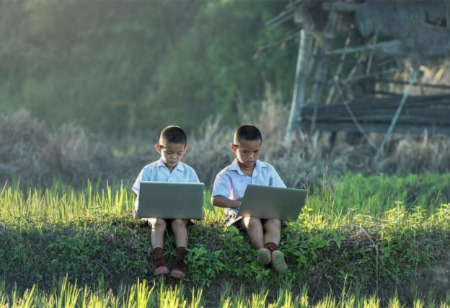
Indonesia starts its SapceX Satellite-based Internet Efforts to Solve its Connectivity Issues


The internet users of Indonesia are connected through mobile phones. Although mobile broadband (3G, but now more frequently 4G/LTE) is Indonesia's most popular internet service, it falls short of fixed broadband in terms of capacity, service quality, high bandwidth performance, and cost-effectiveness.
The limitations of mobile internet were recently brought to light by distance learning initiatives during the COVID-19 pandemic as millions of Indonesian students and teachers discovered that their mobile data plans were insufficient and prohibitively expensive for high bandwidth apps.
To fully profit from a digital economy, the people need to be able to completely harness its economic potential. This highlights two major challenges: how to make fixed broadband internet access universal and improve internet quality.
Why hasn't the Internet Connected Most Parts of Indonesia?
A vital but insufficient solution to addressing the main issues is expanding the optical fiber network coverage. While government initiatives like Palapa Ring[1] and investments by private service providers have continuously improved connectivity and service availability throughout Indonesian districts, internet subscriptions have not grown at the same rate.
Cost and quality issues are highly to blame for the low subscription rates. While fixed broadband packages are expensive compared to comparable packages provided by Indonesia's regional competitors, mobile broadband data packages in Indonesia are reasonably priced.
Aside from expensive fees, Indonesia’s quality of internet service is said to be comparatively lower than its ASEAN neighbours. There are two main factors for high price and low quality internet. Even though mobile networks frequently share infrastructure, this strategy is less popular in the fixed internet broadband sector. Passive infrastructure like ducts, poles, right-of-ways, and civil works often account for between 70 percent and 80 percent of the expenditures associated with fixed broadband. Benefits would include decreased expenses for purchase, leasing, and upkeep if suppliers shared costs.
Second, rather than offering a single universal license for all services, the restricted licensing model compels service providers to bid for service-specific licenses. By restricting market entry, this lessens competition in the broadband sector, which raises consumer costs for services of inferior quality and prevents the adoption of broadband internet.
With the help of Elon Musk's SpaceX and the launch of a satellite, Indonesia has taken action to address the issue of the lack of internet connectivity in some of its remote districts.
First Biggest Government-Owned Satellite
On June 19, 2023, the Satria-1 satellite was launched from the US, with a SpaceX Falcon 9 rocket carrying the payload. The country's first government-owned multi-function satellite with the largest capacity in Asia, the satellite was produced by French defense electronics company Thales at a cost of about $540 million.
According to acting communications and informatics minister Mahfud MD, it will be used to distribute internet access, especially for education, health, and public services in the remote, isolated, and outermost areas and would orbit above the Papua province.
It is said that the satellite will not be fully active until 2024, at which point it will begin offering connection speeds of up to 150 gigabytes per second, which is around three times quicker than the archipelago's current satellite internet bandwidth.
Two-thirds of Indonesia's 280 million people will increase their internet usage thanks to Elon Musk's SpaceX launch of a satellite, and Indonesia's underdeveloped eastern islands would benefit from improved internet connectivity.
By the end of the decade, SpaceX's Indonesia communications satellite launch will make it easier for villagers living in distant areas without access to fiber optics to use the internet. The goal of SATRIA-1 is to improve internet connectivity for all 50,000 public service locations in Indonesia, including free access to schools, medical institutions, and local government offices.
The Launch
The Falcon 9 rocket departed on an Eastern trajectory over the Atlantic Ocean after taking off from Cape Canaveral Space Force Station. SpaceX's Falcon 9 rocket separated from the second stage and prepared for re-entry into the atmosphere 8.5 minutes after liftoff. After the entry burn, the rocket made a successful touchdown on SpaceX's drone ship ‘A Shortfall of Gravitas’ before returning to the offshore location. The first stage booster of the Falcon 9 made a vertical touchdown in the Atlantic Ocean off the coast of Florida.
SATRIA-1 was ultimately deployed less than 37 minutes after liftoff in the Geosynchronous Transfer Orbit after the upper stage of the Falcon 9 continued its mission there. SATRIA will lift itself to a position at 146°E using its thrusters after ejecting from the second stage of the Falcon 9 rocket.
This was the fifth launch of this month and the 39th overall for the Falcon 9. The booster had previously guided four Dragon flights for NASA to the International Space Station, making this its 12th launch and landing overall.
In addition, it has successfully launched eight people, three communication satellites, two space station resupply missions, four Starlink batches, most recently on May 14, 2023.
Other Companies Follow Suit to Introduce Satellite–based Internet
The ministry will also launch Hot Backup Satellite (HBS) in the third quarter of 2023 in addition to SATRIA-1. According to the Ministry of Communication and Informatics, satellites are the finest and fastest option for distributing internet access fairly throughout Indonesia.
In addition to SATRIA-1, a number of other businesses want to offer the nation satellite internet. As an illustration, Starlink already provides internet services in the nation. The satellite internet service, which was introduced earlier this year, may not be as affordable as those provided by SATRIA-1 in rural regions, but it is experiencing substantial demand there.
Another company aiming to offer satellite-based internet to the islands of Indonesia is SES. With the recent deployment of its next-generation constellation satellites, SES, which is already well-known for providing internet services to distant islands in the Pacific, intends to play a bigger role in connecting remote areas in Indonesia.

